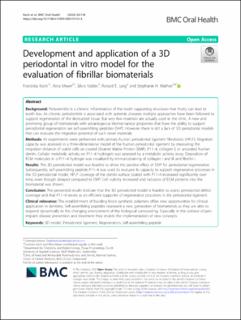Please use this identifier to cite or link to this item:
https://doi.org/10.21256/zhaw-26193| Publication type: | Article in scientific journal |
| Type of review: | Peer review (publication) |
| Title: | Development and application of a 3D periodontal in vitro model for the evaluation of fibrillar biomaterials |
| Authors: | Koch, Franziska Meyer, Nina Valdec, Silvio Jung, Ronald E. Mathes, Stephanie |
| et. al: | No |
| DOI: | 10.1186/s12903-020-01124-4 10.21256/zhaw-26193 |
| Published in: | BMC Oral Health |
| Volume(Issue): | 20 |
| Issue: | 148 |
| Issue Date: | 2020 |
| Publisher / Ed. Institution: | BioMed Central |
| ISSN: | 1472-6831 |
| Language: | English |
| Subjects: | 3D model; Periodontal ligament; Regeneration; Self-assembling peptide |
| Subject (DDC): | 610.28: Biomedicine, biomedical engineering |
| Abstract: | Background: Periodontitis is a chronic inflammation of the tooth supporting structures that finally can lead to tooth loss. As chronic periodontitis is associated with systemic diseases multiple approaches have been followed to support regeneration of the destructed tissue. But very few materials are actually used in the clinic. A new and promising group of biomaterials with advantageous biomechanical properties that have the ability to support periodontal regeneration are self-assembling peptides (SAP). However, there is still a lack of 3D periodontal models that can evaluate the migration potential of such novel materials. Methods: All experiments were performed with primary human periodontal ligament fibroblasts (HPLF). Migration capacity was assessed in a three-dimensional model of the human periodontal ligament by measuring the migration distance of viable cells on coated (Enamel Matrix Protein (EMP), P11–4, collagen I) or uncoated human dentin. Cellular metabolic activity on P11–4 hydrogels was assessed by a metabolic activity assay. Deposition of ECM molecules in a P11–4 hydrogel was visualized by immunostaining of collagen I and III and fibrillin I. Results: The 3D periodontal model was feasible to show the positive effect of EMP for periodontal regeneration. Subsequently, self-assembling peptide P11–4 was used to evaluate its capacity to support regenerative processes in the 3D periodontal model. HPLF coverage of the dentin surface coated with P11–4 increased significantly over time, even though delayed compared to EMP. Cell viability increased and inclusion of ECM proteins into the biomaterial was shown. Conclusion: The presented results indicate that the 3D periodontal model is feasible to assess periodontal defect coverage and that P11–4 serves as an efficient supporter of regenerative processes in the periodontal ligament. Clinical relevance: The establishment of building-block synthetic polymers offers new opportunities for clinical application in dentistry. Self-assembling peptides represent a new generation of biomaterials as they are able to respond dynamically to the changing environment of the biological surrounding. Especially in the context of peri-implant disease prevention and treatment they enable the implementation of new concepts. |
| URI: | https://digitalcollection.zhaw.ch/handle/11475/26193 |
| Fulltext version: | Published version |
| License (according to publishing contract): | CC BY 4.0: Attribution 4.0 International |
| Departement: | Life Sciences and Facility Management |
| Organisational Unit: | Institute of Chemistry and Biotechnology (ICBT) |
| Appears in collections: | Publikationen Life Sciences und Facility Management |
Files in This Item:
| File | Description | Size | Format | |
|---|---|---|---|---|
| 2020_Koch-etal_Development-application-periodontal-model-fibrillar-biomaterials.pdf | 9.57 MB | Adobe PDF |  View/Open |
Show full item record
Koch, F., Meyer, N., Valdec, S., Jung, R. E., & Mathes, S. (2020). Development and application of a 3D periodontal in vitro model for the evaluation of fibrillar biomaterials. BMC Oral Health, 20(148). https://doi.org/10.1186/s12903-020-01124-4
Koch, F. et al. (2020) ‘Development and application of a 3D periodontal in vitro model for the evaluation of fibrillar biomaterials’, BMC Oral Health, 20(148). Available at: https://doi.org/10.1186/s12903-020-01124-4.
F. Koch, N. Meyer, S. Valdec, R. E. Jung, and S. Mathes, “Development and application of a 3D periodontal in vitro model for the evaluation of fibrillar biomaterials,” BMC Oral Health, vol. 20, no. 148, 2020, doi: 10.1186/s12903-020-01124-4.
KOCH, Franziska, Nina MEYER, Silvio VALDEC, Ronald E. JUNG und Stephanie MATHES, 2020. Development and application of a 3D periodontal in vitro model for the evaluation of fibrillar biomaterials. BMC Oral Health. 2020. Bd. 20, Nr. 148. DOI 10.1186/s12903-020-01124-4
Koch, Franziska, Nina Meyer, Silvio Valdec, Ronald E. Jung, and Stephanie Mathes. 2020. “Development and Application of a 3D Periodontal in Vitro Model for the Evaluation of Fibrillar Biomaterials.” BMC Oral Health 20 (148). https://doi.org/10.1186/s12903-020-01124-4.
Koch, Franziska, et al. “Development and Application of a 3D Periodontal in Vitro Model for the Evaluation of Fibrillar Biomaterials.” BMC Oral Health, vol. 20, no. 148, 2020, https://doi.org/10.1186/s12903-020-01124-4.
Items in DSpace are protected by copyright, with all rights reserved, unless otherwise indicated.